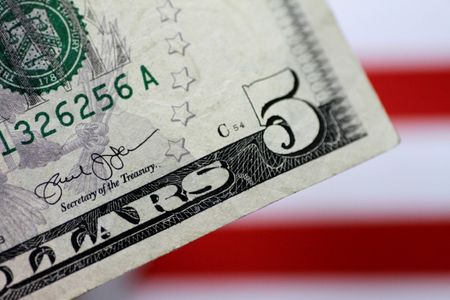Forex
Dollar in demand on rate cut delay concerns, rising risk aversion


© Reuters.
Investing.com – The U.S. dollar climbed higher in early European trade Tuesday, with risk sentiment hit by increased tensions in the Middle East as well as concerns that the Federal Reserve may delay interest rate cuts .
At 04:40 ET (09:40 GMT), the Dollar Index, which tracks the greenback against a basket of six other currencies, traded 0.8% higher at 102.955, after having gained 0.2% overnight in subdued trading during a U.S. public holiday on Monday.
Dollar boosted by risk aversion
Raised tensions in the Middle East have supported the U.S. dollar, after the Houthi group said on Monday it will expand its targets in the Red Sea region to include U.S. ships after the U.S. and British strikes on its sites in Yemen.
However, the main driver of late has been expectations of when the will start cutting interest rates, in effect saying the battle against inflation has been won.
Hawkish comments from European Central Bank officials on Monday have caused traders to push back against the idea of early rate cuts globally.
Attention now turns to a speech by Fed Governor later on Tuesday, an influential member of the central bank’s policy-setting committee.
“Recall that he delivered the definitive and market-moving “something appears to be giving” speech in late November,” said analysts at ING, in a note. “The speech provided an important lead indicator for the Fed’s dovish turn at the December FOMC meeting.”
Sterling retreats after weaker average earnings growth
In Europe, fell 0.5% to 1.2658 after the release of labor data which showed that growth in fell to 6.6% in November, a fall from 7.2% the prior month.
This will be received positively by the Bank of England, as they try to rein in one of the highest inflation rates in the G7, but Wednesday’s release will probably be of more importance.
This is expected to fall to 3.8% on an annual basis, a small fall from 3.9% in November, still way above the central bank’s 2% medium-term target.
dropped 0.5% to 1.0896, with being confirmed at 3.7% on an annual basis in December, a jump from 3.2% the previous month.
“It’s too early to talk about cuts, inflation is too high,” ECB’s Joachim Nagel said on Monday, adding that the mistake of lowering interest rates too early should be avoided.
The euro is struggling to benefit from the hawkish talk though, as the German economy, the eurozone’s largest, is struggling under the weight of the series of interest rate hikes.
The German economy is likely to grow by just 0.3% in 2024, according to the country’s BDI industry association, while forecasting that the global economy will expand by 2.9%.
“The economy is at a standstill in Germany. Compared to most other major industrialised countries, our country is falling further behind,” said BDI president Siegfried Russwurm. “We don’t see any chance of a rapid recovery in 2024.”
Yuan falls to one-month low
In Asia, rose 0.3% to 7.1922, with the yuan retreating to an over one-month low against the dollar, as traders remained largely averse to Chinese assets amid continued concerns over an economic recovery.
Focus was now squarely on fourth-quarter data, due on Wednesday, for more cues on the economy.
traded 0.5% higher to 146.49, after data showed Japanese inflation remained soft in December, coming just a few days before data, which is also expected to show inflation remaining languid.

 Forex3 years ago
Forex3 years agoForex Today: the dollar is gaining strength amid gloomy sentiment at the start of the Fed’s week

 Forex3 years ago
Forex3 years agoUnbiased review of Pocket Option broker

 Forex3 years ago
Forex3 years agoDollar to pound sterling exchange rate today: Pound plummeted to its lowest since 1985

 Forex3 years ago
Forex3 years agoHow is the Australian dollar doing today?

 Cryptocurrency3 years ago
Cryptocurrency3 years agoWhat happened in the crypto market – current events today

 World3 years ago
World3 years agoWhy are modern video games an art form?

 Commodities3 years ago
Commodities3 years agoCopper continues to fall in price on expectations of lower demand in China

 Economy3 years ago
Economy3 years agoCrude oil tankers double in price due to EU anti-Russian sanctions





















